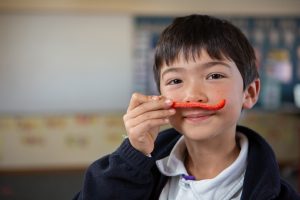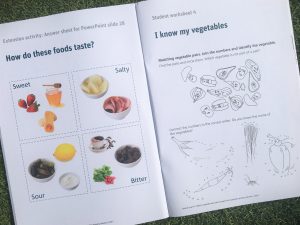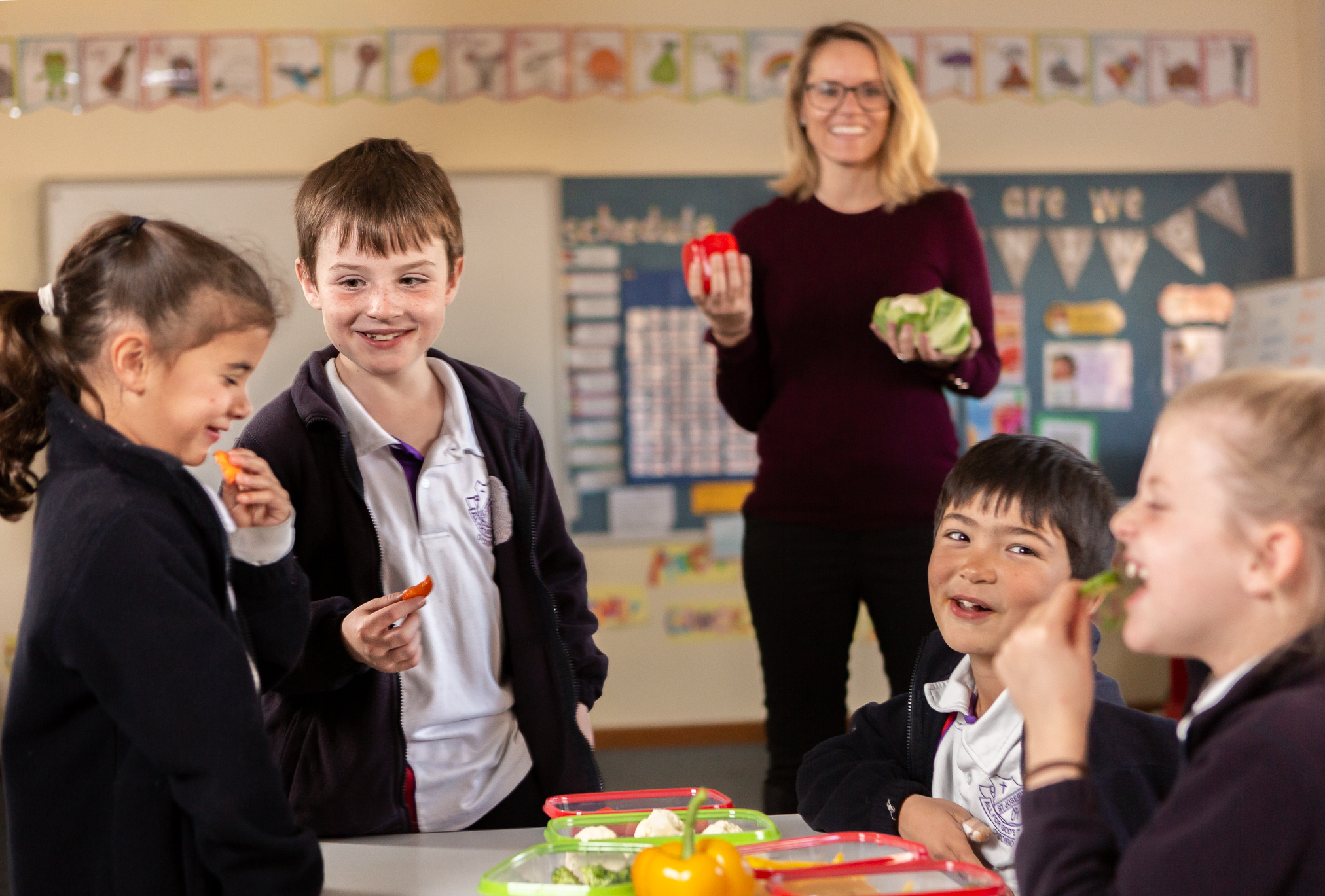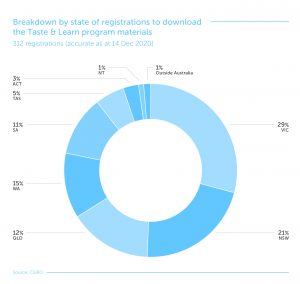Encouraging children to Taste & Learn with new program
With just six per cent of Australian primary school-aged children meeting the recommended daily intake of vegetables, a program has been established by CSIRO scientists and educators to improve kids’ willingness to eat vegetables and provide schoolteachers with simple, hands-on lesson plans aligned with the Australian curriculum. Vegetables Australia reports.
The Taste & Learn™ program is a strategic levy investment under the Hort Innovation Vegetable Fund developed by, and with co-investment from, CSIRO to give Australian primary schoolchildren different experiences with a wide variety of vegetables.
Set over five weeks, the program supports student learning by boosting various skills, including literacy and science. Students learn to describe vegetables in an objective way, using texture, colour and flavour to help children understand what they like about the vegetables they are eating.
CSIRO sensory and consumer scientist and Taste & Learn project leader, Dr Astrid Poelman, said Taste & Learn was based on research over many years into why we like the foods we like, including vegetables.
“We know that children’s vegetable consumption is too low. We also know that one of the reasons is that vegetables don’t appeal very well to humans in their likes and dislikes,” Dr Poelman explained.
“We are born with a liking for sweet tastes, and we are born with a disliking for bitter tastes. It is very early in life that we learn to acquire a liking for salty and fatty tastes. As a category, vegetables are not very sweet and some of them are bitter and they also don’t have much of a salty or a fatty taste. That means that a liking for vegetables is very much a learned behaviour.”
A lot of that learning occurs in childhood, which is why this program is focused on younger children.
“We know that acceptance is a key driver of how much vegetables children eat, and those acceptances and habits carry over from childhood to adulthood. It’s a long-term pathway.”

School focus
The Taste & Learn program is aligned with the Australian curriculum, and has been tested with over 1,600 students and 116 educators across 25 primary schools in New South Wales and South Australia. It is a program for entire primary schools and is delivered across three different stages: the younger years from foundation (or prep) to grade two; grade three to grade four; and grades five and six.
“It’s teacher-led, and each stage consists of five one-hour lessons. We did that quite short on purpose, so that the chances of being able to easily fit it in around other classroom commitments were higher,” Dr Poelman said.
“The program is about giving children experiences with vegetables in different ways. Tastings are critical to it – so children taste at least one vegetable in every lesson and the science framework is then built around how we know children learn to like vegetables.
“Learning to distinguish what each vegetable tastes like – and expressing that – will help them understand what they like and don’t like, which will help them appreciate each food on their own.”
Promising results
Taste & Learn trials have received positive feedback from students and teachers, with encouraging behavioural effects recorded among the schoolchildren.
“It is important to have a strong evidence-base. Governments like programs with a sound evidence base and they are more willing to promote resources that align with public health goals,” Dr Poelman said.
“What we showed is that through the program, students increased their knowledge about vegetables and their senses; they could better verbalise what they were tasting and what they were sensing; it increased their vegetable acceptance; it increased their intentions to consume vegetables; it increased their willingness to eat vegetables; and also the number of new vegetables that they had consumed. Those are all very important outcomes, and the findings have now been published in a journal.
“In addition, we conducted a teacher feedback survey. That was very positively evaluated – they thought it was a great program, very engaging and enjoyable for students. They felt the program was aligned well to the curriculum, and they could implement it in their schools.”
Taste & Learn was launched in August 2020, and through television, radio and print, reached more than two million Australians.

Getting involved
All Taste & Learn resources are available to schools for free, and there is an easily accessible website where they can download the material (see information box).
“The resources that are there are written lesson manuals – fully written lesson plans that have got electronic whiteboard support; sheets that students can complete as part of the lessons; and a manual for teachers on how to implement the program that has a theoretical background. There is also practical information about how to implement the program in their school,” Dr Poelman said.
Australia’s vegetable growers are encouraged to get in touch with their local educators, primary school teachers and communities about Taste & Learn.
“I think it would good if growers could help to spread the message. They are all over Australia and represent all different areas so in your communities, spread the word as much as possible. Speak to schools and encourage them to have a look at the resources and give it a go,” Dr Poelman said.
The bottom line
Ultimately, Taste & Learn is set to raise awareness of vegetables and increase acceptance of vegetables, which has a positive effect on consumption.
“As part of the program, there are some activities where parents are involved, so they are aware of what’s happening through homework exercises. When parents know that children are following this program and are more susceptible to eating vegetables, they can start adding more vegetables on the plate and different types of vegetables, and it may have a flow-on effect,” Dr Poelman explained.
“We also are engaging with state governments to support further roll out among schools. In addition, we are working towards other activities; for example, increasing vegetable offerings in canteens. While in the classroom, children learn about vegetables and acquire more of a liking of vegetables. Then that will be followed by more vegetable dishes in the canteen, which will lead to increased consumption.
“We need to see this as one pillar in a suite of activities that can lead to increased vegetable consumption.”
Find out more
Please visit research.csiro.au/taste-and-learn.
This project has been funded by Hort Innovation using the vegetable research and development levy and contributions from the Australian Government.
Project Number: VG16064
Cover image: CSIRO’s Taste & Learn program teaches kids to like vegetables. Images courtesy of CSIRO.
Grower support for new veg education program
AUSVEG Deputy Chair Belinda Adams – a leafy vegetable grower from the Gold Coast and former primary school teacher – has thrown her support behind Taste & Learn, saying it will be an important program to help encourage children to want to eat more vegetables as well as equip teachers with the resources to teach kids about their vegetables.
“Educating children about vegetables and encouraging them to want to eat more is critical to improving the health and wellbeing of our children. A vegetable-rich diet in childhood has been proven time and time again to improve physical and physiological development in children and can be a strong influence in dietary choices as they move into adulthood,” Ms Adams said.
“If we can teach our children and students to eat a variety of vegetables and appreciate the taste and texture of different vegetables, then we can dramatically improve the health outcomes of the Australian population well into the future.

“Vegetable growers are deeply passionate about producing high quality vegetables and are extremely proud of the work that goes into growing the produce that makes its way to consumers.
“If, as an industry, we can help students and children learn to love and appreciate their vegetables, then everyone will benefit, from growers, to parents, children and even government from improved health outcomes, reduced health spending and increased vegetables sales.”


